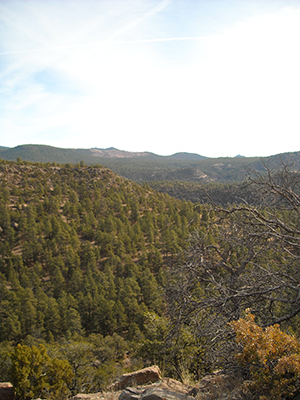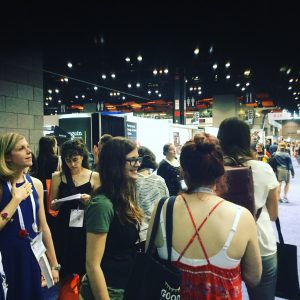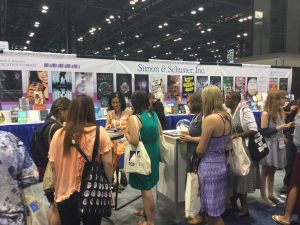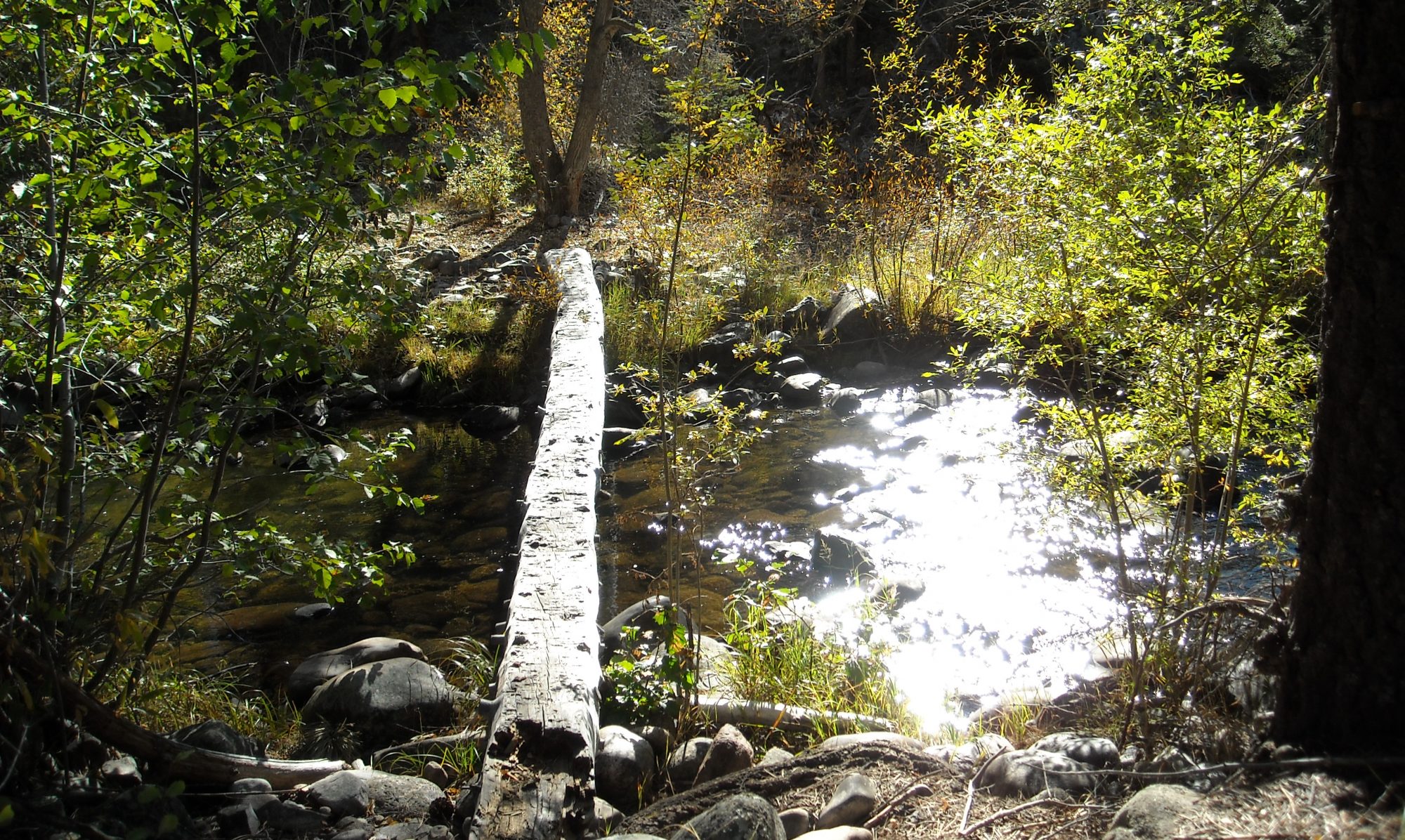- The Goblin Emperor by Katherine Addison– I loved this so much that as soon as I finished it I started over from the beginning, and once I finished my re-read I went straight to…
- The Witness for the Dead by Katherine Addison – which I also loved.
- Riccardino by Andrea Camilleri, translated by Stephen Sartarelli
- Stories from Apex: “On the Sunlit Side of Venus” by Benjamin Parzybok and “The Day When the Last War Is Over” by Sergey Gerasimov
- The Wood Wife by Terri Windling (re-read)
- Gossamer Axe by Gael Baudino (re-read)
- The Kingdoms by Natasha Pulley
- The Gatekeeper by James Byrne
- A Master of Djinn by P. Djèlí Clark
- Kindness Now by Amanda Gilbert
- Radical Compassion by Tara Brach
- Witches by Brenda Lozano, translated by Heather Cleary: loved this one.
- Woman of Light by Kali Fajardo-Anstine
- Dark Earth by Rebecca Stott: loved this one too
- When We Were Birds by Ayanna Lloyd Banwo: and loved this as well.
- Seasparrow by Kristin Cashore: I was afraid to start this book, as I love Cashore’s work in general but had such huge problems with her last book. I was worried that I might have similar issues with Seasparrow–but I didn’t! I read it fast enough that I don’t want to say more than that (am going back to re-read), but my first impression is positive.
What I’ve been reading lately, plain February edition
- Winterkeep, by Kristin Cashore. I had some problems with this one, though I did read it all the way through, not just once but twice. Kristin Cashore is one of “my” writers and so her works get a level of trust from me that many other authors’ don’t. For this reason I found reading Winterkeep an interesting exercise in figuring out what my problems with it were. I think it comes down to three main issues (no real spoilers in what follows). First is a world-building issue. Cashore’s previous novels in this universe (Graceling, Fire, and Bitterblue) suffered from a common and extremely problematic issue in fantasy: presumed (and in some cases explicit) whiteness (some discussions of this issue in fantasy generally here and here). Perhaps in part to remedy this, in Winterkeep Cashore presents a nation of people with brown skin, and clarifies that the Lienid are also brown-skinned (albeit lighter-skinned than the people of Winterkeep). All this is well and good, except that by this choice, Cashore has created a world in which human phenotype is completely unmoored from biological reality (the people of Winterkeep live in the far north). This worldbuidling thus gives credence to some mistaken ideas about the biology of skin color and race; such mistaken ideas inform quite a bit of present-day scientific racism (this project provides some background for what I’m trying to get at here), which is clearly not what Cashore intends – but nonetheless, it bothered me. I couldn’t not see those threads as I read. My second issue is also science-related. While environment is at the heart of the conflict in Winterkeep, and Cashore emphasizes this by having two point-of-view and one additional important set of non-human animal characters, all the animals seem completely human-focused. These three types of animals are the only wild animals we’re introduced to (and one, the telepathic foxes, would really have to be considered a semi-domesticate); otherwise the world is populated by domestic animals (that is, dependent on humans) such as cows, pigs, and cats. This wouldn’t be too much of a problem except that the responsibility of the denizens of Winterkeep to take care of the earth and the impacts of their decisions on ecosystem dynamics are a significant part of the plot. Similarly, while concepts such as cascading environmental effects and ecosystem mechanics are touched upon, the superficial way in they are treated supports the idea that people are the superior beings, the most important part of this world…which is directly in conflict with the stated environmental themes of Winterkeep. Finally, one of the aspects of this book that I really liked was the theme of coming of age out of a background of family trauma. However, the many viewpoints (there are five) made it hard for me to fully connect with the character of Lovisa. And this made the way in which Winterkeep treats family trauma, for me, fundamentally unsatisfying. Together these three issues made the entire book problematic for me; they may not be so much of an issue for other readers. But thinking about why things were problematic for me in this one was also a really fruitful and interesting exercise – one that’s given me some insights into writing craft.
- Interior Chinatown, by Charles Yu. I loved this book.
- The Banished Immortal: A Life of Li Bai, by Ha Jin.
- Making Magic: Weaving Together the Everyday and the Extraordinary, by Briana Saussy
Winter is coming: some seasonal reads

I am not a winter person. I was born in a tropical environment, and although I didn’t live there long enough to remember it, I think maybe it got into my bones. The dark, the cold, the sleeping plants, the swirling dead leaves…they bring me down. Even though winter is (usually) relatively short where I live, it always feels like it will never end.
This year, the cold has arrived early in central New Mexico. Our frosts began early in October; at Samhain it is predicted to dip into the teens. The garden is fully dead; we’ve had to move the potted plants into the house; and the furnace is not yet on.
I am cold, inside and out.
I have two strategies for adjusting to the cold season. One is to get outside and exercise until I warm up. The other is the opposite: to curl up under a warm blanket with a cup of tea, and read. In honor of the latter, I’d like to share a few of my favorite autumn/winter seasonal books – books that warm me when I am cold, books that help me see the beauty of winter, books that reassure me that warmth does exist out there and will come again. Some are explicitly seasonal, some are explicitly cozy, some are both, some are neither. They are all flawed. But I find them comforting as the cold and dark advance.
In no particular order:
- A is for Alibi – What better, on a cold night, than to immerse oneself in Grafton’s 1980s California? The earlier books in her alphabet series work better for me than the later ones this time of year.
- The Cuckoo’s Calling – This is the first of J.K. Rowling’s Robert Galbraith mysteries. It’s got all sorts of flaws and things that bug me, but I also find it super-compelling.
- Ha’penny – Set in an alternate-history London, this mystery is set in July but feels cold to me. It’s by Jo Walton.
- The Pillars of Hercules – I find travel books a wonderful escape when the weather is cold, even when they are describing cold places. Theroux’s depiction of winters in Spain reminds me of my times living in southwest Europe.
- A Perfect Spy – I only discovered this classic recently. I read it over the summer but it’s more a winter read for me.
- Waiting for Winter – this picture book is sadly out of print, but I love it.
- The Shortest Day – This new presentation of Susan Cooper’s poem has truly fantastic illustrations. And what better than a solstice book for coming to terms with winter?
- Bitterblue – I love Kristin Cashore’s writing in general; Bitterblue is my Cashore comfort read for autumn.
- Sunshine and Beauty – I discovered both these books by Robin McKinley in the autumn, many years ago. They have become inextricably linked to late October for me, and I re-read them every year.
- Tam Lin – the story takes place over four years at college, and therefore includes the full seasonal round of those four years. But it has a very autumnal feeling for me, and I don’t think I’m misleading by calling it a Samhain book.
- Coyote Tales – among many Indigenous peoples, Coyote tales can only be told in the winter, from the first frost through the first lightning. I spent enough time living on reservations that I picked up this prohibition. Now, I find reading Coyote tales to be one of the joys of the season. There are lots of different published versions of different Coyote Tales from different Indigenous groups out there; the link above is to one of many.
- Georgie – I loved this picture book as a child; I rediscovered it during one of its periodic reprintings. It’s out of print again now, but it’s widely available in libraries and can also be found used.
- The Snowman – a classic and another childhood favorite.
- The Feast Nearby – a memoir about seasonal eating. Though much of it takes place in spring and summer, the author’s focus during those seasons is largely preparing for winter.
- Six Seasons – Seasonal cookbooks have become rather trendy in the past few years; this one, in my opinion, is one of the best. The six seasons it uses as an organizing principle aren’t the same as seasons in New Mexico, but I still love it.
- The Wood Wife – This book is set in Tucson, where I lived briefly, and captures fall in the Sonoran Desert beautifully.
- The Zen of Gardening in the High and Arid West – Gardening catalogs, some of the best cozy reads, start coming in December, usually. Before they arrive I rely on gardening books. This one is one of my favorites.
- Classic German Baking – My go-to source for traditional German seasonal cookies (it’s got four different recipes for Lebkuchen). It’s great for other seasons too, but winter solstice in northern Europe is something special.
What I’ve been reading, coping with winter edition
Recently finished:
- The Bloodprint, by Ausma Zehanat Khan (Sirens Reading Challenge book)
- Where the Mountain Meets the Moon, by Grace Lin (re-read; Sirens Reading Challenge book)
- Goodbye Stranger, by Rebecca Stead (reread)
- Jane, Unlimited, by Kristin Cashore (reread)
- 2 ARCs from ALA midwinter
What I’ve been reading, July 2017 travel edition
I had planned to write extensive reviews of the various things I’ve been reading, but the fact is that I’m not great at writing extensive reviews. At least not on demand, and not while traveling, especially not while traveling for work. So instead, here’s what I’ve been reading with a few short thoughts.
Acquired at ALA:
- Disappeared by Francisco X. Stork. This is a bit of a departure from Stork’s previous work, as it’s a thriller (though still written for the young adult market). At the same time all the elements that I love about his writing – a fundamental kindness towards humanity, the struggle with the “real world,” an underlying attention to issues of spirituality – are in it. I’m not objective about Stork’s work as (like Cashore) he’s one of my favorite authors, but I thought this was a fantastic read (and possibly one of my favorites of his). It’s due out in September 2017.
- Leona: the Die is Cast by Jenny Rogneby. Swedish thriller (the Swedish version was published a few years ago; the version I got is the English translation, the paperback of which is due out on August 1, 2017). This one wasn’t for me.
- Murder in Saint-Germain by Cara Black. Mystery, part of a series about Parisian PI Aimée Leduc. Again, not for me.
- White Chrysanthemum by Mary Lynn Bracht. This is the story of a young Korean woman kidnapped and forced to work as a Japanese “comfort woman” during World War II. I read it while sitting at a cafe waiting for my short-term apartment to become available and cried myself into a pulp – and this despite some unbelievable elements. Maybe not the best choice for reading in public, but definitely moving! It’s due out in January 2018.
- Minik: the New York Eskimo by Kenn Harper. This biography of Minik, one of six Polar Inuit brought to New York by Robert Peary, is another heartbreaker. Minik was seven when he arrived in New York, and four of his traveling companions (including his father) died within months of their arrival. The fifth returned to Greenland, but Minik remained in New York. While I’ve long known the story of the Inuit group in New York (it’s one of the more shameful chapters in American anthropological history), Mink’s story after that first year was new to me. The back cover copy reads “…Minik never surrendered the home of going ‘home,’ never stopped fighting for the dignity of his father’s memory, and never gave up his belief that people would come to his aid if only he could get them to understand” and this is a fair summary of the book, I think. The are passages from Minik’s own writings included in the biography, and these I found especially compelling. This revised and updated edition of Give Me My Father’s Body is due out in September 2017.
Other:
- Want by Cindy Pon. This is another author about whom I’m not objective, and it’s also a departure from her previous work. Want is young adult science fiction, set in a near-future Taiwan, rather than fantasy. It has an interesting combination of political, heist, and romance elements, making for a fun and page-turning read. Others agree with me: Want has been recommended in the LA Times and the New York Times. Out now.
- The Waking Land by Callie Bates. I have to admit I picked up this beautiful adult fantasy because I liked the cover so much…but I’m glad I did. The magic in this book is what really drew me in, but there are many other things to like: heroine fighting against the odds, interesting world, etc. Out now.
- Fire by Kristin Cashore. A re-read of an old favorite.
JANE, UNLIMITED
Every once in a while I read something new and realize, “this is one of my authors.” And I will then track down everything that person has ever written, and (if they are alive) will wait eagerly for their next book. I don’t, of course, enjoy all books by these authors equally, but I always like to read them; even when an individual book doesn’t work for me, because of my relationship with that author’s writing I will read anything the author publishes, usually more than once.
Readers of this blog will already know: Kristin Cashore is one of these authors for me. I truly enjoy her writing, whether it’s a book or her blog. Her new book Jane, Unlimited will be released this fall, and I was lucky enough to get a (signed!) copy at ALA last week. Naturally it was on the top of my ALA pile.
I won’t spoil anything by saying that this book is very, very different from Cashore’s other three books – but at the same time, I can see connections. Imagine a mashup of a Choose-Your-Own-Adventure book, Run Lola Run, and Italo Calvino’s If on a Winter’s Night a Traveler; add in a dash of Daphne du Maurier’s Rebecca; and write it explicitly for 21st century young adults and in Cashore’s inimitable style, and you’ll be there.
So yeah, it was a little weird. I liked it; it was both fun and interesting. I maybe wished for a little more tying-together of the various plots in some way, but I’ll see if that feeling persists on a re-read. I did gather (from the book’s acknowledgements) that Jane, Unlimited was, in original drafts, an actual choose-your-own adventure, written in second person and with various decision points. So maybe the lack of integration is deliberate. I also felt like the house, though definitely a character (more in some plots than others) was not as fully realized as it might have been, but again that might just be a first-read impression….
Whatever else one might say, though, Jane, Unlimited is both different and daring. I also found it fun. Definitely, I’ll be re-reading it.
Next up: Disappeared by Francisco X. Stork
The ALA 2017 exhibits experience and THE GLASS SENTENCE
Every few years, I get to attend the American Libraries Association (ALA) conference, courtesy of my partner (who is a librarian). I tag along to whatever cool location in which the meeting is being held and get an exhibits-only pass. Why bother getting a pass? One simple reason: ALA exhibits are *awesome*.
They have robots. Author talks. Publisher displays, from publishers large and small, with recently published and forthcoming books. Sometimes they give some of those books away. In fact for me the most difficult aspect of going to ALA exhibits, aside from the general overstimulating nature of it all, is not picking up too many books.

(There are lots of other things in the ALA exhibits as well as books and book-related booths, like displays on library automation software and databases. I like those too.)
This year ALA was in Chicago. Not only did I wind up with a number of exciting-looking books (most of which I knew nothing about prior to the conference)…
I watched a cooking demo by Joshua McFadden…

I got an advance copy of Jane Unlimited by Kristin Cashore…

and I met up with the fantastic Cindy Pon!

To top that all off I spent some time exploring Chicago, including eating pierogis at Tryzub, a Ukranian restaurant; experiencing the Purple Pig; and exploring Read It & Eat, a cookbook-focused bookstore.
Yes, I spent all my time reading, eating, and talking with other people about reading and eating. And if that doesn’t sound totally worth the price of admission to you, well, probably you don’t read this blog.
(I did also attend the Chicago – Orlando MLS game, but I ate and drank while there so technically this is in the “eating” category. I didn’t read at the game, but it was still super-fun.)
In the midst of all this activity I also finished The Glass Sentence by S.E. Grove, a book I’ve been meaning to read since it came out. I definitely enjoyed it – it has great world-building and does interesting things with the concept of time. As this review points out it’s in the tradition of Philip Pullman‘s His Dark Materials trilogy, but (maybe because of the American setting) to me it had a very different feel. I’m still mulling over my reaction beyond “I liked it,” though. I suspect I won’t really know until I’ve read the other two in the series.
However, those other two books will have to wait, much as I enjoyed The Glass Sentence. My reading for the next few weeks will focus on the Advance Reader Copies/other books I picked up at ALA, so stay tuned for some thoughts on those!
